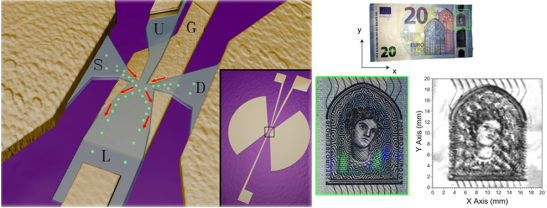
The research group of Prof. Aimin Song from the School of Microelectronics has made new progress in the field of 2D material-based THz detectors. The result has been published in Nano Letters (IF: 11.24) with title “Terahertz Detection and Imaging Using Graphene Ballistic Rectifiers”. Prof. Song is the corresponding author and the work was collaborated with the University of Manchester and the University of Montpellier.
Interest in terahertz (THz) detection originates from a wide range of applications in the fields of medicine, security, and nondestructive quality testing that are either complementary to or simply cannot be achieved by techniques in other electromagnetic radiation frequency bands. Radiation in the THz frequency region can penetrate common dielectric materials that would otherwise be opaque at optical frequencies. It is also both nonionizing (therefore safer than X-rays) and capable of being used to identify materials spectroscopically. Current THz detection technology requires cryogenic cooling to reach a very high sensitivity, e.g., a typical superconducting bolometer has a noise equivalent power (NEP) in the order of 1 pW Hz–1/2at 8 K. Room-temperature devices (such as pyroelectric detectors or Golay cells) are usually limited to an NEP of 10 pW Hz–1/2. Both these cryogenic and room-temperature devices suffer from slow response times due to their working principles, hence limiting modulation frequencies to∼100 Hz. An alternative to these detectors is to use an antenna coupled to a high-speed nonlinear electronic component such as a Schottky diode or a field effect transistor (FET). The combination of an antenna with a rectifying element is aptly named the rectenna. The functionality of a rectenna is fundamentally limited by the properties of the rectifying element, and most Schottky diodes have a cutoff frequency well below 1 THz unless a challenging nanoscale air-bridge to one of the electrodes can be fabricated in order to reduce the parasitic capacitance. Furthermore, due to the exponential current–voltage characteristics of Schottky diode, the input dynamic range in which the diode shows a linear input-power dependence or quadratic behavior is often quite limited.
Although graphene has the longest mean free path of carriers of any known electronic material at room temperature, very few types of novel device structures have been reported to harness this extraordinary property to achieve a higher performance than using conventional electronic materials. A ballistic nano-rectifier is fabricated by creating an asymmetric cross-junction in a single-layer graphene sandwiched between two boron nitride flakes. By integrating the graphene ballistic rectifier with an antenna, a rectenna was demonstrated as a THz detector. A small-area (<1 μm2) local gate is used to adjust the Fermi level in the device to optimize the output while minimizing the impact on the cutoff frequency. The device operates in both n- and p-type transport regimes and shows a peak extrinsic responsivity of 764 V/W and a corresponding noise equivalent power of 34 pW Hz–1/2at room temperature with no indications of a cutoff frequency up to 0.45 THz. The device also demonstrates a linear response for more than 3 orders of magnitude of input power due to its zero threshold voltage, quadratic current–voltage characteristics and high saturation current. Finally, the device is used to take an image of an optically opaque object at 0.685 THz, demonstrating potential in both medical and security imaging applications.
In the past few years, Prof. Song and his research group has made a series of advances in the THz detectors, such as the graphene ballistic nano-rectifier with very high responsivity (Nature Communications, 7, 11670, 2016, IF:12.12), and ballistic rectifiers using CVD graphene (Carbon, 84, 124, 2015, IF:8.82). The work was supported by the National Key R&D Program of China (2016YFA0301200), National Natural Science Foundation of China (11374185), Engineering and Physical Sciences Research Council (EP/M507969/1, EP/ G03737X/1, EP/N021258/1), the Agence nationale de la Recherche project Integrated Nano-Detectors for terahertz Applications (ANR-13-NANO-0008), the Terahertz Platform TOP and by the Occitanie region via the Gepeto Terahertz platform, and by Eranet-Rus-Plus European program Terasens.